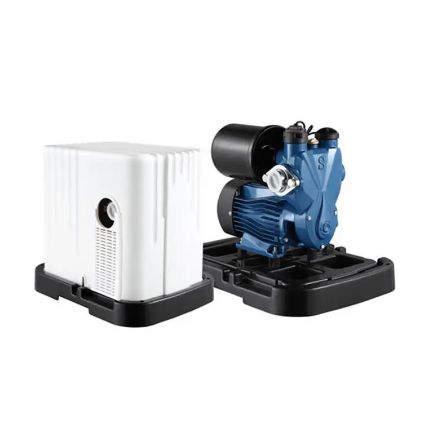There are many types of GK-CB High-Pressure Self-Priming Pump structures, among which, the working principle of the external-mixed self-priming pump is to fill the pump shell with water before starting the pump (or there is water in the pump shell itself). After startup, the impeller rotates at high speed to make the water in the impeller channel flow to the volute. At this time, a vacuum is formed at the inlet to open the inlet check valve. The air in the suction pipe enters the pump and reaches the outer edge through the impeller channel.

On the other hand, the water discharged into the gas-water separation chamber by the impeller flows back to the outer edge of the impeller through the left and right return holes. Under the effect of pressure difference and gravity, the water returned from the left return hole shoots into the impeller channel and is broken by the impeller. After mixing with the air from the suction pipe, the water is thrown to the volute and flows in the direction of rotation. Then it converges with the water from the right backwater hole and flows along the spiral case.
As the liquid continuously impacts the cascade in the volute and is constantly broken by the impeller, it is strongly mixed with the air to generate the gas-water mixture, and the continuous flow causes the gas-water cannot be separated. The mixture is stripped by the tongue at the outlet of the volute and enters the separation chamber along the short tube. The air in the separation chamber is separated and discharged by the outlet pipe, while the water still flows to the outer edge of the impeller through the left and right return holes and is mixed with the air in the suction pipe. In this way, the air in the suction pipeline is gradually exhausted, and the water enters the pump to complete the self-priming process.
The working principle of the internal mixing self-priming pump is the same as that of the external mixing self-priming pump. The difference is that the return water does not flow to the outer edge of the impeller, but to the inlet of the impeller. When the internal mixing self-priming pump is started, the reflux valve at the front and bottom of the impeller must be opened to make the liquid in the pump flow back to the impeller inlet. The water is mixed with the air from the suction pipe under the action of the high-speed rotation of the impeller to form a gas-water mixture and discharge it to the separation chamber. Here the air is discharged and the water returns to the impeller inlet from the return valve. Repeat this process until the air is exhausted and water is absorbed.
The self-priming height of the self-priming pump is related to the factors such as the front seal clearance of the impeller, the number of revolutions of the pump, and the liquid level height of the separation chamber. The smaller the seal clearance in front of the impeller, the greater the self-priming height, generally 0.3~0.5 mm; When the clearance increases, the head and efficiency of the pump will decrease except the self-priming height. The self-priming height of the pump increases with the increase of the circumferential speed u2 of the impeller, but when the self-priming height of zui is large, the number of revolutions increases, but the self-priming height does not increase any more, at this time, the self-priming time is only shortened;
When the number of revolutions decreases, the self-priming height decreases. Under the condition that other conditions remain unchanged, the self-priming height also increases with the increase of water storage height (but it cannot exceed the Zui water storage height of the separation chamber). In order to better mix the air and water in the self-priming pump, the blades of the impeller must be less, so as to increase the pitch of the cascade; It is better to use semi-open impeller (or impeller with wider impeller channel), which is more convenient for the backwater to be deeply injected into the impeller cascade.
Most of the self-priming pumps are matched with the internal combustion engine and installed on a mobile car, which is suitable for field operation.
Post time: Feb-28-2023